Choosing the right washing machine is crucial, especially for busy households. With various sizes, features, and installation options available, it’s essential to make the right choice.
This guide helps you navigate through questions like whether you need a separate tumble dryer, how to buy integrated units, and understanding today’s energy ratings. Read on to find out.
Types of Washing Machines
Washing machines come in four main types: top loaders, washer dryers, integrated, and freestanding machines. Your choice depends on the installation location.
Top Load Washing Machine
The top-loading washing machine, while less common nowadays, still offers some benefits. Instead of a front door, you load it from the top.
Compared to front-loading machines, top loaders are faster (agitator machines) and more efficient in water and electricity use. However, they require more space as they can’t fit under a worktop.
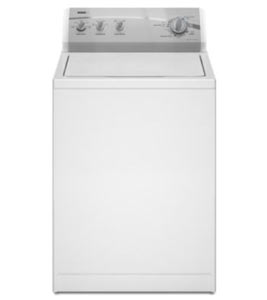
Top loading washing machine – image courtesy of 215laundry.com
Integrated Washing Machine
An integrated washing machine blends seamlessly into your kitchen, fitting neatly under a worktop.
These machines allow you to attach a cupboard door to the front, matching your kitchen unit doors for a uniform look.
While they offer a tidy appearance, integrated washing machines are often slightly smaller than other front-loading models.
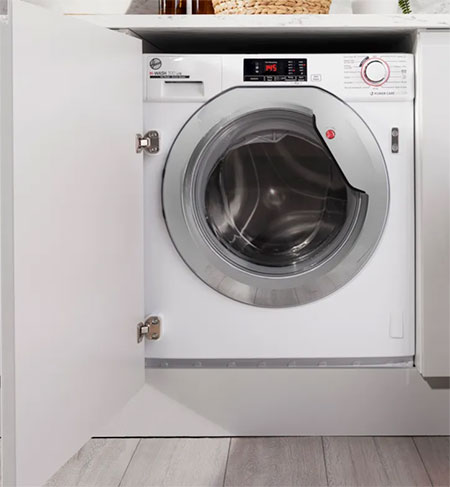
Integrated washing machine
Freestanding Washing Machine
A freestanding washing machine is exactly as it sounds – it stands on its own. You can install it anywhere with plumbing, a waste pipe, and a power socket.
These machines can fit under a worktop or be stacked with a tumble dryer if space allows.
Due to their versatility, freestanding washing machines are the most commonly purchased and used type.
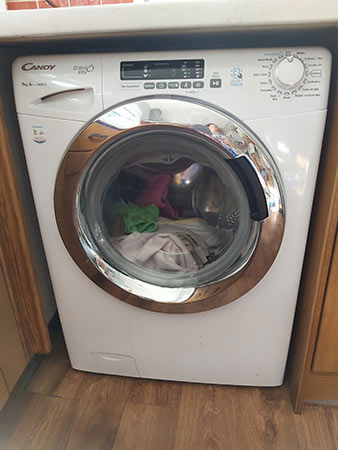
Freestanding washing machine installed under a worktop
Washer Dryers
A washer dryer is exactly what it sounds like – a washing machine and tumble dryer combined into one unit.
Primarily designed for smaller living spaces like flats, they save space by performing both functions.
While they’re not as effective as separate machines, they’re sufficient when space is limited.
They can be stacked like freestanding machines, but you’ll also need to install a vent pipe for the dryer, typically requiring access to an external wall.
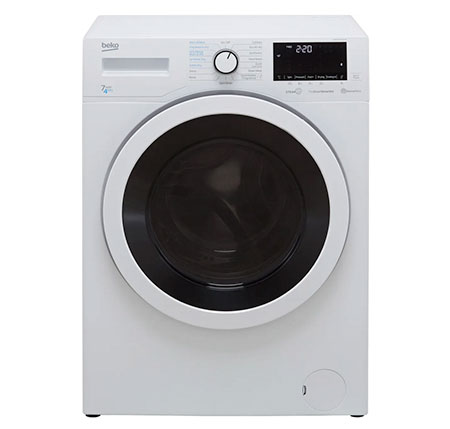
Washer dryer – Washing machine with inbuilt tumble dryer
Washing Machine Sizes
When considering a new washing machine, the main questions are usually about its width and height.
Most washing machines are designed to fit within a standard kitchen unit space of 600mm wide and under a worktop about 900mm high (though they typically measure around 850-870mm in height).
The depth varies based on the drum size, with smaller 6-7kg machines around 40-45mm deep and larger 9kg machines up to 600mm deep, but usually not more to fit standard kitchen setups.
Top-loading machines, however, tend to be taller due to their design.
Washing Machine Drum Sizes
Domestic washing machine drums come in three main size bands: 5-7kg, 8-9kg, and 10kg+.
- 5-7kg: Ideal for smaller spaces like flats. 5kg suits individuals, while 7kg is suitable for small families.
- 8-9kg: Suited to larger homes, fitting families of average size (8kg) or larger families (9kg).
- 10kg+: Designed for spacious homes, accommodating large families with six or more members.
Some models go up to 12kg, mainly for industrial use or very large families, but they often fit in standard spaces.
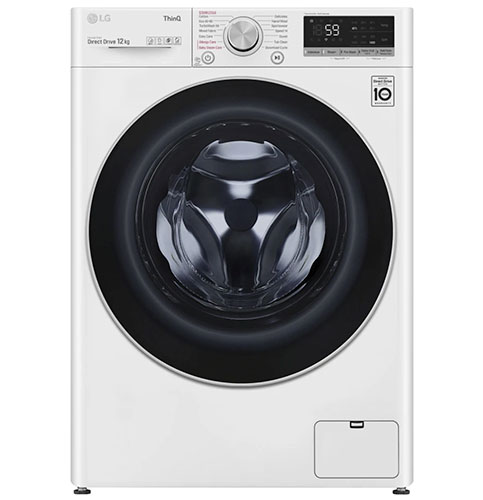
Large 12kg washing machine
Measuring for Your Washing Machine
Before purchasing or replacing a washing machine, measure the available space to ensure your chosen machine will fit properly.
Most properties have a designated area with an electrical socket, water supply, and waste pipe. If not, hire a plumber and electrician to set up the necessary connections. While you can plumb the waste yourself with guidance, electrical work requires a qualified electrician.
Typically, the designated space measures:
- 600mm width: Standard kitchen cabinet size
- 600mm depth: Depth of a standard kitchen worktop
- Approximately 880mm (ish) height: Height of a kitchen worktop minus its thickness
Most free-standing washing machines fit within these dimensions. However, consider any obstacles at the back of the space, like water pipes or sockets, as they affect how far the machine can be pushed back. Objects behind the machine can also impact its positioning under the unit, so take note of these factors.
Can You Install a Washing Machine Yourself?
Absolutely. Installing a washing machine is usually straightforward: connect the water supply hose, insert the waste pipe into the waste trap, and plug the machine into an electrical socket.
The only challenge arises if the necessary connections aren’t available.
If you’re handy with DIY, you can install waste pipes and cold water supply yourself. However, if there are no electrical sockets nearby, you’ll likely need a qualified electrician to install one.
How Much do Washing Machines Cost?
Washing machines vary widely in price. Budget-friendly options start around £180 to £200, while larger, more premium models can exceed £1000.
However, prices can vary even within the same capacity range. For example, a smaller 6kg machine from a lesser-known brand might cost £200, whereas a similar-sized machine from a reputable manufacturer could be over £350.
Ultimately, aim for the best quality you can afford, as quality often correlates with price.
Reducing Washing Machine Running Costs
Washing machines, alongside other “wet appliances”, contribute about 10% to yearly electricity usage in homes, says the Energy Saving Trust. Trimming expenses in this area can significantly impact your finances.
For instance, a medium-sized family using a 7kg machine for a full wash every other day (roughly 220 times annually) can expect annual costs between £25 and £35 – see the Energy Saving Trust article here for more information.
The running costs of a washing machine depend largely on its usage frequency and efficiency. A smaller 5kg machine used weekly costs less than a 9kg machine used daily.
Choosing shorter, cooler wash cycles can substantially reduce energy usage. Opting for a 30-minute wash over a 60-minute one and lowering the temperature from 40°C to 30°C are eco-friendly and cost-effective choices.
Some modern machines even wash efficiently at 20°C, reflecting growing environmental awareness.
Never run a machine half full. Wait until you have a full load, as this saves significantly over time.
If your machine is old and inefficient, consider investing in a newer, more eco-friendly model. Many retailers offer recycling services when delivering new machines.
Given rising energy costs, prioritise machines with high efficiency ratings for both water and electricity usage.
Manufacturers often provide information on typical usage and costs for their machines, so review this data carefully to estimate annual expenses.
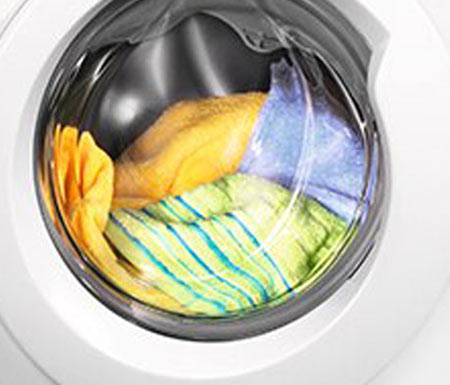
Avoid running washing machines half full
Common Washing Machine Programs and Features
While washing machines vary widely among manufacturers, many share common features that cater to different needs. When shopping for a new machine, it’s crucial to consider these features and how they align with your requirements.
Key programs and features include:
- Automatic Programme: Adjusts water usage and wash duration based on the load size.
- Easy Iron Options: Minimize wrinkles in clothes, simplifying ironing.
- Delayed Start: Enables starting the wash cycle during off-peak electricity hours e.g. Economy 7 and the likes.
- Quick Wash Cycles: Shortens wash time for convenience.
- Delicate Programs: Gentle cycles for fragile fabrics.
Understanding these features will help you choose the right washing machine for your needs.
Quick/Rapid Wash Cycle
A quick wash cycle is a valuable feature for cost-conscious users. Typically lasting 40 to 45 minutes, some models even offer a 15-minute option.
This feature enables you to launder small or lightly soiled loads more efficiently, saving time and energy compared to longer cycles.
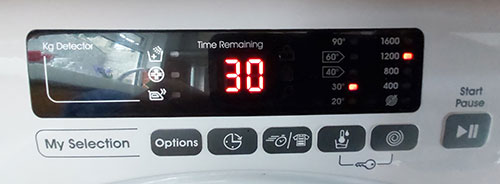
30-minute quick wash feature
Temperature Control
Adjusting the temperature of your wash cycle is as crucial as opting for a quick or rapid wash. Whether it’s a standard program or a quick wash, having the flexibility to change the temperature is essential.
Lowering the temperature from a standard 40° to 30° or even lower for lightly soiled clothes not only saves money but also benefits the environment. Even a 10° difference can make a significant impact!

Switching from a 40° to a 30° wash can yield significant savings!
Spin Speed Control
Adjusting the spin speed of your washing machine is crucial. It determines how fast the drum rotates during the spin cycle. Most washing machines offer up to 1200 rpm spin, but some go even faster, up to 1600rpm.
A higher spin speed removes more water from clothes, aiding faster drying, especially in colder months when using a tumble dryer, which can be costly. However, note that faster spin cycles can slightly reduce the machine’s lifespan due to increased forces and vibrations. Also, avoid high-speed spins for delicate fabrics like wool and silk.
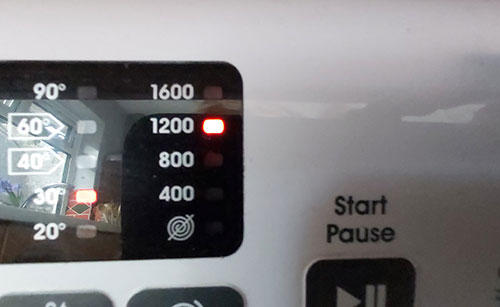
Spin cycle selection on washing machine
Quiet Operation
If you live in a flat, have an open plan kitchen, or young children, a quiet washing machine is essential. Full spin cycles can be noisy, especially at night, potentially disturbing neighbours or family members.
Modern “ultra quiet” washing machines operate so silently that it’s often hard to tell if they’re running.
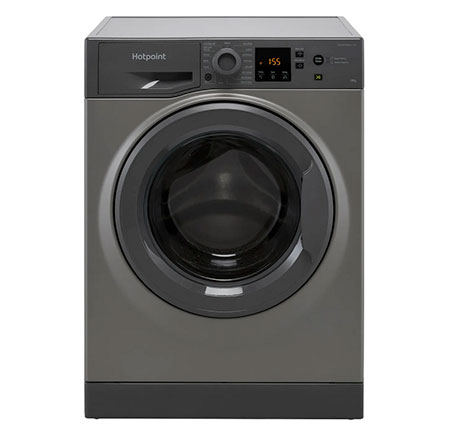
Hotpoint ultra quiet washing machine
Automatic Dosing
Automatic dosing, a modern washing machine innovation, calculates the precise amount of detergent needed based on the weight of your laundry. It dispenses the detergent at the optimal time, improving washing results while reducing detergent usage.
Smart Connectivity
Smart connectivity refers to the integration of “smart technology” into washing machines, allowing them to connect to the internet.
With this feature, a washing machine can link to WiFi and be controlled via an app. This enables adjustments to settings, scheduling of wash cycles, monitoring of usage data, diagnosing of issues, and more—all conveniently from a smartphone or tablet.
Self-Cleaning Feature
Cleaning your washing machine is nobody’s favorite task. From detergent tray to door seal and beyond, dirt and scum can accumulate. Plus, the deeper internals typically require a professional’s touch.
Luckily, many modern machines come with a self-cleaning function. Simply add a specialized cleaning product and activate the clean cycle. This thoroughly cleans the drum and pipework, eliminating sludge and gunk buildup.
Allergy Sensitivity
For those with sensitive skin, the feel of clothes and their cleanliness is crucial to comfort and quality of life.
To address this, modern machines often feature an allergy or sensitivity setting. This setting adds extra rinses to thoroughly remove detergent, pet hair, dust, pollen, and other contaminants, ensuring clothes are free from irritants.
Fuzzy Logic
Found in many modern washing machines, the fuzzy logic feature operates much like autodosing. It weighs the laundry load and then determines the most efficient wash setting automatically.
Steam Treatment
Some modern washing machines utilize steam generated during wash cycles to treat your clothing in a steaming cycle.
This process sanitizes your laundry, eliminating bacteria, and reduces creases, cutting down on ironing time and electricity usage.
Add to Wash
This is a newer feature found on select machines.
We’ve all experienced the frustration of forgetting to add an item to the wash, especially when it’s needed urgently. In the past, this meant wasting energy and money on a separate wash cycle for just a few items.
Now, some machines offer a convenient door or pause feature that allows you to add missed items mid-wash!
Understanding Washing Machine Energy Ratings
Every washing machine receives an Energy Rating Label, graded from A (best) to G (least efficient).
Higher-rated machines use less water and power. Introduced by the EU in 1995, this system sparked innovation in efficiency.
Newer labels like A+, A++, and A+++ recognised even higher efficiency. However, the abundance of A+++ ratings led to confusion and slowed innovation.
Post-Brexit, a simplified A-G scale was re-introduced and replaced the A+ system in March 2021. Now, A+++ equals B or C, A++ equals D or E, and A+ equals F or G.
These changes aim to reignite innovation and provide clearer information for consumers.
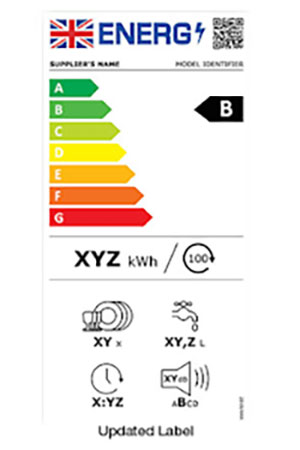
New energy rating label introduced in the UK on March 1, 2021
Repair or Replace: What to Do with a Faulty Washing Machine
In the past, it was common to replace a broken appliance with a new one, contributing to our “throw away” culture. However, as environmental concerns grow, this mindset is shifting.
New legislation now mandates manufacturers to provide spare parts for a minimum period, making repairs more feasible and reducing waste.
So, should you repair your washing machine? Yes, especially if it’s still modern and energy-efficient. Insurance often covers repairs, making it now very a viable option.
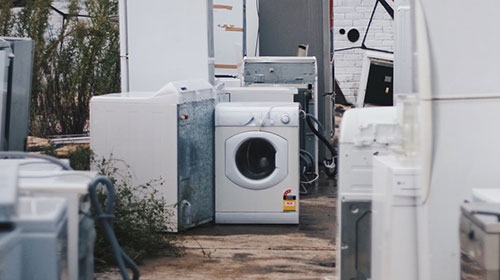
Old and discarded appliances – Image courtesy of rubbishplease.co.uk
Recycle Old Appliances
If you are unable to get your existing machine repaired and have to get a new one, then one thing you can ensure is that your old one is recycled. many white goods suppliers now offer a recycling service whereby when they deliver your new machine they will also take your old machine away and ensure it is responsibly recycled and doesn’t go to waste.
With today’s environmental concerns, this really is an absolute must!
Also, when shopping around for a new machine, ensure you choose one that has also been built responsibly, by a company that recognises the need for environmental awareness.
When buying a new washing machine, ask yourself essential questions: How often will you use it? Will it fit your space? Do you prefer a front loader or a top loader? What’s your budget?
Don’t overspend on features you won’t use. Base your choice on your needs, not sales pitches!

